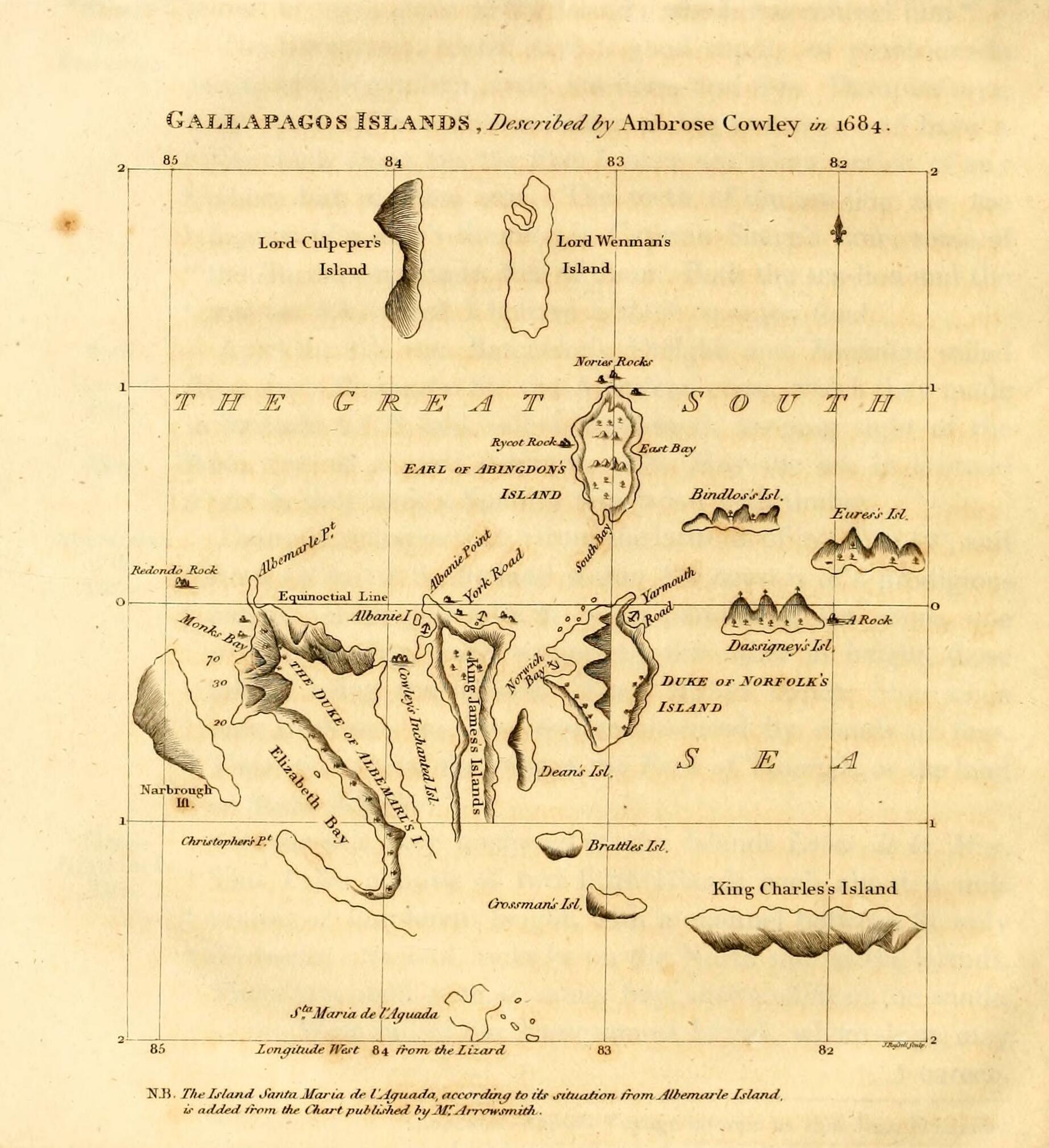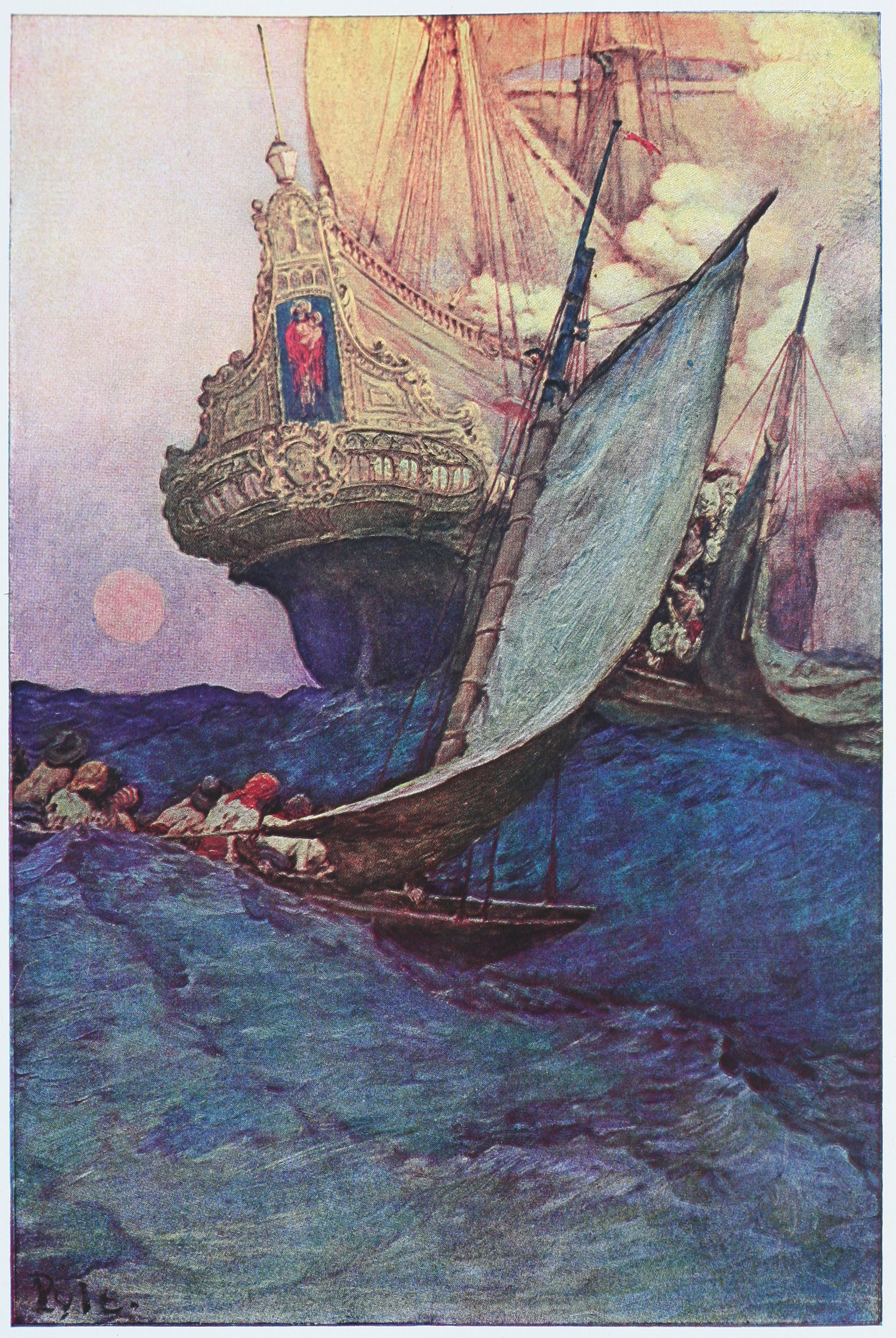|
Ambrose Cowley
William Ambrosia Cowley, also known as Ambrose Cowley and Captain Cowley, was a 17th-century English people, English buccaneer who surveyed the Galápagos Islands during his 1683–1686 circumnavigation of the world while serving under several captains such as John Eaton (pirate), John Eaton, John Cook (pirate), John Cook, and later Edward Davis (buccaneer), Edward Davis. Cowley drafted the first chart of the islands in 1684, first published with the account of his voyage in 1699. In his diary he reported the discovery of the phantom island, phantom Pepys Island, allegedly situated north of the Falkland Islands, prompting a number of mariners to look in vain for the nonexistent rock. References *William Ambrosia Cowley. ''Cowley's Voyage Round the Globe'', in ''Collection of Original Voyages'', ed. William Hacke. London: James Knapton, 1699. https://web.archive.org/web/20180120160933/http://www.galapagos.to/TEXTS/COWLEY.HTM *1686 “A Short Account of My Voyage Round this Terest ... [...More Info...] [...Related Items...] OR: [Wikipedia] [Google] [Baidu] |
English People
The English people are an ethnic group and nation native to England, who speak the English language in England, English language, a West Germanic languages, West Germanic language, and share a common ancestry, history, and culture. The English identity began with the History of Anglo-Saxon England, Anglo-Saxons, when they were known as the , meaning "Angle kin" or "English people". Their ethnonym is derived from the Angles (tribe), Angles, one of the Germanic peoples who invaded Great Britain, Britain around the 5th century AD. The English largely descend from two main historical population groups: the West Germanic tribes, including the Angles, Saxons, and Jutes who settled in England and Wales, Southern Britain following the withdrawal of the Ancient Rome, Romans, and the Romano-British culture, partially Romanised Celtic Britons who already lived there.Martiniano, R., Caffell, A., Holst, M. et al. "Genomic signals of migration and continuity in Britain before the Anglo-Sa ... [...More Info...] [...Related Items...] OR: [Wikipedia] [Google] [Baidu] |
Buccaneer
Buccaneers were a kind of privateer or free sailors, and pirates particular to the Caribbean Sea during the 17th and 18th centuries. First established on northern Hispaniola as early as 1625, their heyday was from the Restoration in 1660 until about 1688, during a time when governments in the Caribbean area were not strong enough to suppress them. Martinique was a home port for French buccaneers as well as pirates like Captain Crapeau. Originally the name applied to the landless hunters of wild boars and cattle in the largely uninhabited areas of Tortuga and Hispaniola. The meat they caught was smoked over a slow fire in little huts the French called ''boucans'' to make ''viande boucanée'' – ''jerked meat'' or '' jerky'' – which they sold to the corsairs who preyed on the (largely Spanish) shipping and settlements of the Caribbean. Eventually the term was applied to the corsairs and (later) privateers themselves, also known as the Brethren of the Coast. Although c ... [...More Info...] [...Related Items...] OR: [Wikipedia] [Google] [Baidu] |
Galápagos Islands
The Galápagos Islands () are an archipelago of volcanic islands in the Eastern Pacific, located around the equator, west of the mainland of South America. They form the Galápagos Province of the Republic of Ecuador, with a population of slightly over 33,000 (2020). The province is divided into the Cantons of Ecuador, cantons of San Cristóbal Island, San Cristóbal, Santa Cruz Island (Galápagos), Santa Cruz, and Isabela Island (Galápagos), Isabela, the three most populated islands in the chain. The Galápagos are famous for their large number of Endemism, endemic species, which were studied by Charles Darwin in the 1830s and inception of Darwin's theory, inspired his theory of evolution by means of natural selection. All of these islands are protected as part of Ecuador's Galápagos National Park and Galápagos Marine Reserve, Marine Reserve. Thus far, there is no firm evidence that Polynesian expansion, Polynesians or the indigenous peoples of South America, Indigenous pe ... [...More Info...] [...Related Items...] OR: [Wikipedia] [Google] [Baidu] |
Circumnavigation Of The World
This is a list of circumnavigations of Earth. Sections are ordered by ascending date of completion. Global Nautical 16th century * The 18 survivors, led by Juan Sebastián Elcano (Spanish), of Ferdinand Magellan's Spanish expedition (which began with 5 ships and 270 men); 1519–1522; westward from Spain; in . After Magellan was killed by Lapulapu off the Philippines on 27 April 1521, the circumnavigation was completed under the command of the Basque Spanish seafarer Juan Sebastián Elcano who returned to Sanlúcar de Barrameda, Spain, on 6 September 1522, after a journey of 3 years and 1 month. These men were the first to circumnavigate the globe. * The survivors of García Jofre de Loaísa's Spanish expedition 1525–1536 including Andrés de Urdaneta; westward from Spain. None of Loaísa's seven ships completed the voyage, but ''Santa María de la Victoria'' reached the Moluccas before being wrecked in a Portuguese attack. Successive chiefs of the expedition (Loaísa, Elc ... [...More Info...] [...Related Items...] OR: [Wikipedia] [Google] [Baidu] |
John Eaton (pirate)
John Eaton (fl. 1682-1686) was an English buccaneer and pirate active off the coasts of Spanish Central and South America. He circumnavigated the world before returning to England. History Originally a merchant captain, Eaton commanded the 80-man, 250 ton, 20-gun ''Nicholas'' out of London when he sailed for Danish St. Thomas in 1683. After a visit to Cape Verde and a raiding spree along the Brazilian coast (including time spent alongside pirate George Bond), Eaton rounded the Strait of Magellan in early 1684. It was there he met the ''Cygnet'' under Charles Swan, who tried to conduct legitimate trade with the Spanish before turning to piracy. ''Nicholas'' soon met with the ''Bachelor's Delight'' under John Cook (who soon died and was replaced by Edward Davis) and separated from ''Cygnet''. Eaton and Davis sailed together for several months, attacking Spanish shipping off Peru and other settlements. They met at Cocos Island, La Plata, and Juan Fernandez before Davis sailed ... [...More Info...] [...Related Items...] OR: [Wikipedia] [Google] [Baidu] |
John Cook (pirate)
John Cook (died 1684) was an English buccaneer, privateer, and pirate. History In 1679, when he was still a merchant captain, Cook abandoned his ship on the island of Bonaire to escape the Spanish. He then joined the assembly of buccaneers serving under Bartholomew Sharpe. The fleet separated in 1681 after disagreements between Captains Sharpe, John Coxon (pirate), John Coxon, and John Watling; Cook led a group electing to leave the South Seas and return to the West Indies. Among the sailors joining him were surgeon Lionel Wafer and navigator William Dampier. Cooke then sailed with the crew of William Wright (privateer), William Wright and Jan Willems (Dutch buccaneer), Jan Willems (aka "Yankey"), serving as quartermaster until granted command of a ship they had taken. Unfortunately, the French authorities of Santo Domingo confiscated the ship for piracy because he had failed to obtain a privateering commission. In 1682 Cook and a few men (including Edward Davis (buccaneer), E ... [...More Info...] [...Related Items...] OR: [Wikipedia] [Google] [Baidu] |
Edward Davis (buccaneer)
Edward Davis or Davies (fl. c. 1680–1688) was an English buccaneer active in the Caribbean during the 1680s and would lead successful raids against Leon and Panama in 1685, the latter considered one of the last major buccaneer raids against a Spanish stronghold. Much of his career was later recorded by writer William Dampier in ''A New Voyage Round the World'' (1697). Early career Possibly of Flemish ancestry, he is first recorded as one of the members of the ''Pacific Adventure'' led by Bartholomew Sharp and John Coxon in 1680. But first and foremost he emerges in the Caribbean on a French privateer commanded by Captain Yanky. He was transferred to Captain Tristian's ship, the crew mutinied at Petit-Goâve, southwest of Port-au-Prince in Saint-Domingue (Haiti). Davis then sailed under Capt John Cook arriving in April 1683 at Chesapeake Bay, where he met William Dampier. Briefly serving as a navigator, he and several others including James Kelly left the expediti ... [...More Info...] [...Related Items...] OR: [Wikipedia] [Google] [Baidu] |
Phantom Island
A phantom island is a purported island which was included on maps for a period of time, but was later found not to exist. They usually originate from the reports of early sailors exploring new regions, and are commonly the result of navigational errors, mistaken observations, unverified misinformation, or deliberate fabrication. Some have remained on maps for centuries before being "un-discovered". Unlike lost lands, which are claimed (or known) to have once existed but to have been swallowed by the sea or otherwise destroyed, a phantom island is one that is claimed to exist contemporaneously, but later found not to have existed in the first place (or found not to be an island, as with the Island of California). Examples Some may have been purely mythical, such as the Isle of Demons near Newfoundland, which may have been based on local legends of a haunted island. The far-northern island of Thule was reported to exist by the 4th-century BC Greek explorer Pytheas, but in ... [...More Info...] [...Related Items...] OR: [Wikipedia] [Google] [Baidu] |
Pepys Island
Pepys Island is a phantom island, once said to lie about north of the Falkland Islands at 47°S.James BurneyA Chronological History of the Discoveries in the South Sea Or Pacific Ocean accessed 25 July 2010 Pepys Island is now believed to have been a misidentified account of the Falkland Islands. Original identification In December 1683 the British corsair William Ambrose Cowley, master of the ''Bachelor's Delight'', a ship of 40 guns proceeding on a circumnavigation of the globe, discovered at a latitude stated as 47°S a previously uncharted and unpopulated island in the South Atlantic which he named "Pepys Island", for Samuel Pepys, Secretary to the Admiralty. His companion on the voyage, William Dampier, considered the sighting to be the "Sebaldinas Islands", an alternative name at the time for the Falklands. Cowle's log entry reads:Antonio de Viedma, ''Diarios de navegación – expediciones por las costas y ríos patagónicos'' (1780–1783), Ediciones Continente reprint ... [...More Info...] [...Related Items...] OR: [Wikipedia] [Google] [Baidu] |
Falkland Islands
The Falkland Islands (; ), commonly referred to as The Falklands, is an archipelago in the South Atlantic Ocean on the Patagonian Shelf. The principal islands are about east of South America's southern Patagonian coast and from Cape Dubouzet at the northern tip of the Antarctic Peninsula, at a latitude of about 52°S. The archipelago, with an area of , comprises East Falkland, West Falkland, and 776 smaller islands. As a British Overseas Territory, the Falklands have internal self-governance, while the United Kingdom takes responsibility for their defence and foreign affairs. The capital and largest settlement is Stanley, Falkland Islands, Stanley on East Falkland. The islands are believed to have been uninhabited prior to European discovery in the 17th century. Controversy exists over the Falklands' discovery and subsequent colonisation by Europeans. At various times, the islands have had French, British, Spanish, and Argentine settlements. Britain Reassertion of Britis ... [...More Info...] [...Related Items...] OR: [Wikipedia] [Google] [Baidu] |





